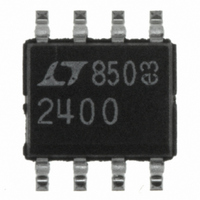LTC2400CS8#PBF Linear Technology, LTC2400CS8#PBF Datasheet - Page 19

LTC2400CS8#PBF
Manufacturer Part Number
LTC2400CS8#PBF
Description
IC A/D CONV 24BIT MICRPWR 8-SOIC
Manufacturer
Linear Technology
Datasheet
1.LTC2400CS8PBF.pdf
(40 pages)
Specifications of LTC2400CS8#PBF
Number Of Bits
24
Sampling Rate (per Second)
7.5
Data Interface
MICROWIRE™, Serial, SPI™
Number Of Converters
1
Power Dissipation (max)
1mW
Voltage Supply Source
Single Supply
Operating Temperature
0°C ~ 70°C
Mounting Type
Surface Mount
Package / Case
8-SOIC (0.154", 3.90mm Width)
Lead Free Status / RoHS Status
Lead free / RoHS Compliant
Available stocks
Company
Part Number
Manufacturer
Quantity
Price
APPLICATIONS
HIGH state. This will cause the device to exit the internal
serial clock mode on the next falling edge of CS. This can
be avoided by adding an external 10k pull-up resistor to
the SCK pin or by never pulling CS HIGH when SCK is LOW.
Whenever SCK is LOW, the LTC2400’s internal pull-up at
pin SCK is disabled. Normally, SCK is not externally driven
if the device is in the internal SCK timing mode. However,
certain applications may require an external driver on SCK.
If this driver goes HI-Z after outputting a LOW signal, the
LTC2400’s internal pull-up remains disabled. Hence, SCK
remains LOW. On the next falling edge of CS, the device is
switched to the external SCK timing mode. By adding an
external 10k pull-up resistor to SCK, this pin goes HIGH
once the external driver goes HI-Z. On the next CS falling
edge, the device will remain in the internal SCK timing
mode.
A similar situation may occur during the sleep state when
CS is pulsed HIGH-LOW-HIGH in order to test the conver-
sion status. If the device is in the sleep state (EOC = 0), SCK
will go LOW. Once CS goes HIGH (within the time period
defined above as t
For a heavy capacitive load on the SCK pin, the internal
(INTERNAL)
SDO
SCK
CS
CONVERSION
EOCtest
U
), the internal pull-up is activated.
INFORMATION
BIT 31
U
EOC
SLEEP
BIT 30
Figure 10. Internal Serial Clock, Continuous Operation
W
–0.12V
BIT 29
SIG
REF
TO 1.12V
0.1V TO V
U
BIT 28
EXR
1 F
2.7V TO 5.5V
V
REF
V
REF
CC
IN
BIT 27
MSB
V
V
V
GND
CC
REF
IN
LTC2400
pull-up may not be adequate to return SCK to a HIGH level
before CS goes low again. This is not a concern under
normal conditions where CS remains LOW after detecting
EOC = 0. This situation is easily overcome by adding an
external 10k pull-up resistor to the SCK pin.
Internal Serial Clock, 2-Wire I/O,
Continuous Conversion
This timing mode uses a 2-wire, all output (SCK and SDO)
interface. The conversion result is shifted out of the device
by an internally generated serial clock (SCK) signal, see
Figure 10. CS may be permanently tied to ground (Pin 4),
simplifying the user interface or isolation barrier.
The internal serial clock mode is selected at the end of the
power-on reset (POR) cycle. The POR cycle is concluded
approximately 0.5ms after V
weak pull-up is active during the POR cycle; therefore, the
internal serial clock timing mode is automatically selected
if SCK is not externally driven LOW (if SCK is loaded such
that the internal pull-up cannot pull the pin HIGH, the
external SCK mode will be selected).
DATA OUTPUT
BIT 26
SDO
SCK
CS
F
O
V
CC
= 50Hz REJECTION
= EXTERNAL OSCILLATOR
= 60Hz REJECTION
LSB
BIT 4
24
CC
exceeds 2.2V. An internal
BIT 0
LTC2400
CONVERSION
19
2400 F10













